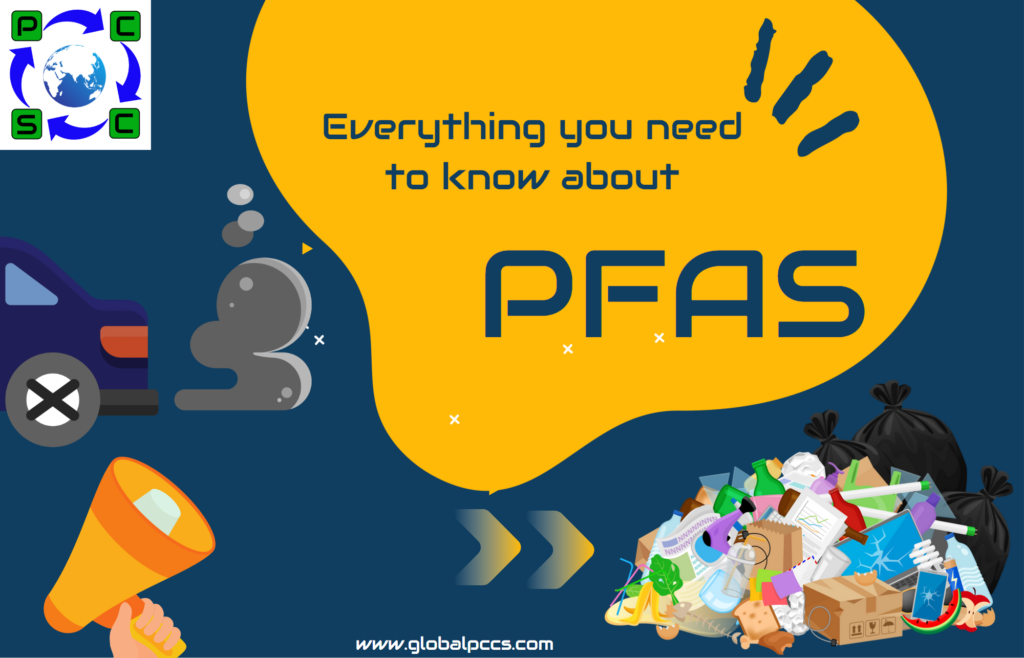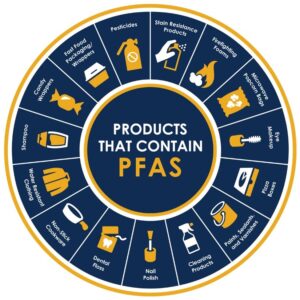
Background:
Per- and polyfluoroalkyl substances (PFAS) are a large class of thousands of synthetic chemicals that are used throughout society. However, they are increasingly detected as environmental pollutants, and some are linked to negative effects on human health.
They all contain carbon-fluorine bonds, which are one of the strongest chemical bonds in organic chemistry. This means that they resist degradation when used and in the environment.
Most PFAS are also easily transported in the environment covering long distances away from the source of their release.
PFAS has been frequently observed to contaminate groundwater, surface water and soil. Cleaning up polluted sites is technically difficult and costly. If releases continue, they will continue to accumulate in the environment, drinking water and food.
What are PFASs?
Per- and polyfluoroalkyl substances (PFAS) are a group of man-made chemicals that includes PFOA, PFOS and many other chemicals. Examples of PFAS can be found include cleaners, textiles, leather, paper and paints, fire-fighting foams, and wire insulation.
Characteristics of PFAS:
- Is very persistent in the environment.
- Is found at very low levels both in the environment and in the blood.
- Remains in people for a very long time.
- They are stable under intense heat.
- Causes developmental and other adverse effects in laboratory animals.
Uses of PFOA, PFOS, and other PFAS:
PFAS are widely used as they have unique desirable properties.
- Many of them are also surfactants and are used as water and grease repellents.
- PFOA was used as an aqueous dispersing agent to make fluoropolymers.
- Fluoropolymers impart valuable properties, including fire resistance and oil, stain, grease, and water repellency to articles.
- They are used in many industry segments, including aerospace, automotive, building/construction, chemical processing, electronics, semiconductors, and textile industries, food processing, and medical articles.
- Where can we find PFAS?

Picture credit: https://riversideca.gov/press/understanding-pfas
What are the concerns?
- The majority of PFAS are persistent in the environment. Some PFAS are known to persist in the environment longer than any other synthetic substance.
- Because of this persistence, if PFAS continues to be released to the environment, humans and other species will be exposed to ever greater concentrations.
- Even if all releases of PFAS would cease tomorrow, they would continue to be present in the environment, and humans, for generations to come.
- The behavior of PFAS in the environment means that they tend to pollute groundwater and drinking water, which is difficult and costly to remediate.
- Certain PFASs are toxic for reproduction and can harm the development of fetuses. Several PFAS may cause cancer in humans. Some PFAS are also suspected of interfering with the human endocrine (hormonal) system.
How PFAS are exposed?
- PFAS are released into the environment from direct and indirect sources, for example, from professional and industrial facilities using PFAS, during use of consumer products (e.g., cosmetics, ski waxes, clothing) and from food contact materials.
- Humans can be exposed to them every day at home, in their workplace and through the environment, for example, from the food they eat and drinking water.
How are PFASs regulated in the EU?
- Since 2009, perfluoro octane sulfonic acid and its derivatives (PFOS) have been included in the international Stockholm Convention to eliminate their use.
- The Stockholm Convention also regulates the global elimination of perfluorooctanoic acid (PFOA), its salts and PFOA-related compounds. PFOA has been banned under the POPs Regulation since 4 July 2020.
- In June 2022, the Stockholm Convention parties decided to include PFHxS, its salts and related compounds in the treaty. This global ban is expected to enter into force at the end of 2023.
- Long-chain perfluorinated carboxylic acids (C9-21 PFCAs) are being considered for inclusion in the Stockholm Convention and consequent global elimination.
Substances of very high concern under REACH:
A few PFAS are on the REACH Candidate List of substances of very high concern (SVHC):
Three groups of PFAS were identified as SVHCs.
- PFOA:
2,3,3,3-tetrafluoro-2-(hepta fluoro propoxy)propionic acid, its salts and its acyl halides (HFPO-DA), a short-chain PFAS substitute for PFOA in fluoropolymer production, was the first substance added to the Candidate List.
Its ammonium salt is commonly known as GenX.
- Perfluoro butane sulfonic acid (PFBS) and its salts, a replacement of PFOS
- Perfluoro heptanoic acid (PFHpA) and its salts
Effects:
- These PFAS were identified as of equivalent concern to carcinogens, mutagens and reprotoxicants and persistent, bio accumulative and toxic/very persistent and very bio accumulative (PBTs/vPCBs) chemicals.
- Can harm the unborn child.
- Some are suspected of interfering with human hormonal system.
Proposed restriction: BAN
Ban on manufacture, use and placing on the market.
- As substances on their own
- As a constituent > 25 ppb for any PFASs
- As a mixture > 250 ppb for sum of PFASs
- An article > 50 ppm for PFASs
REACH restrictions:
- Perfluorinated carboxylic acids (C9-14 PFCAs), their salts and precursors will be restricted in the EU/EEA from February 2023.
- Norway and Germany have proposed a restriction on perfluorohexane-1-sulphonic acid (PFHxS), its salts and related substances.
- ECHA introduced a restriction proposal for PFAS used in firefighting foams.
Conclusion:
The PFAS identification was based on their persistence, mobility, and toxicity, which were considered to pose a threat to human health and wildlife when exposed through the environment (including through drinking water).
Over the past decades, global manufacturers have started to replace certain PFAS with other PFAS or with fluorine-free substances.
Source: https://echa.europa.eu/hot-topics/perfluoroalkyl-chemicals-pfas








 Authorised IMDS & CDX Training & Consulting partner for
Authorised IMDS & CDX Training & Consulting partner for






